实验03
实验一
button.hpp
#pragma once #include<iostream> #include<string> class Button{ public: Button(const std::string &label_); const std::string &get_label() const; void click(); private: std::string label; }; Button::Button(const std::string &label_):label{label_}{ } inline const std::string &Button::get_label() const{ return label; } inline void Button::click(){ std::cout << "Button '" << label << "' clicked\n"; }
window.hpp
#pragma once #include<iostream> #include<vector> #include<algorithm> #include "button.hpp" class window{ public: window(const std::string &title_); void display() const; void close(); void add_button(const std::string &label); void click_button(const std::string &label); private: bool has_button(const std::string &label) const; private: std::string title; std::vector<Button> buttons; }; window::window(const std::string &title_):title{title_}{ buttons.emplace_back(Button("close")); } inline void window::display() const { std::string s(40,'*'); std::cout << s << std::endl; std::cout << "window;" << title << std::endl; int cnt=0; for(const auto &button:buttons) std::cout << ++cnt << ". " << button.get_label() << std::endl; std::cout << s << std::endl; } inline void window::close(){ std::cout << "close window '" << title << "'" << std::endl; click_button("close"); } inline bool window::has_button(const std::string &label) const { for(const auto &button:buttons) if(button.get_label()==label) return true; return false; } inline void window::add_button(const std::string &label){ if(has_button(label)) std::cout << "button " << label << " already exists!\n"; else buttons.emplace_back(Button(label)); } inline void window::click_button(const std::string &label){ for(auto &button:buttons) if(button.get_label()==label){ button.click(); return; } std::cout << "no button: " << label <<std::endl; }
task1.cpp
#include "window.hpp" #include<iostream> void test(){ window w("Demo"); w.add_button("add"); w.add_button("remove"); w.add_button("modify"); w.add_button("add"); w.display(); w.close(); } int main(){ std::cout << "用组合类模拟简单GUI:\n"; test(); }
编译运行结果如下:
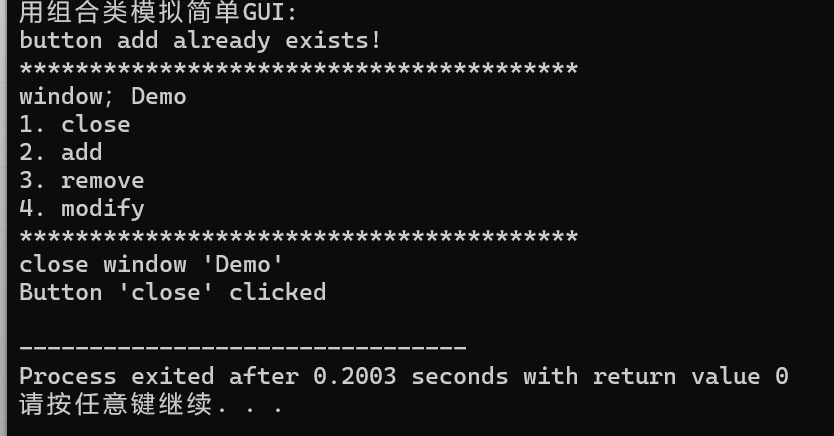
问题一:是组合关系。
问题二:(1)优点:外部代码可以直接调用这个接口,增加灵活性。
风险:破坏代码封装性,增加维护成本。
(2)如果这个成员是外部代码完成功能必须用到的就要设置为public,反之,若外部代码不需要直接使用,就设置为private。若成员被外部调用后容易导致内部状态混乱,就设置为private。
问题三:
接口一:性能:返回引用,不需要拷贝字符串,开销小性能好。
安全性:返回const引用,外部无法修改内部的字符串,安全性较好。
接口二:
性能:返回值拷贝,有额外的内存分配和数据复制开销,性能比返回引用差。
安全性:返回拷贝后的新对象,安全性高。
问题四:修改后程序正常运行push_back是先创建Button(xxx)这个临时对象,再把这个临时对象拷贝到容器中。emplace_back是直接在容器内存里构造Button对象,不需要先创建临时对象,更高效。
实验任务2:
task2.cpp
#include<iostream> #include<vector> void test1(); void test2(); void output1(const std::vector<int> &v); void output2(const std::vector<int> &v); void output3(const std::vector<std::vector<int>>& v); int main(){ std::cout << "深复制验证1:标准库vector<int>\n"; test1(); std::cout << "\n深复制验证2:标准库vector<int>嵌套使用\n"; test2(); } void test1(){ std::vector<int> v1(5,42); const std::vector<int> v2(v1); std::cout << "**********拷贝构造后**********\n"; std::cout << "v1: ";output1(v1); std::cout << "v2: ";output1(v2); v1.at(0)=-1; std::cout << "**********修改v1[0]后**********\n"; std::cout << "v1: ";output1(v1); std::cout << "v2: ";output1(v2); } void test2(){ std::vector<std::vector<int>> v1{{1,2,3},{4,5,6,7}}; const std::vector<std::vector<int>> v2(v1); std::cout << "**********拷贝构造后**********\n"; std::cout << "v1: ";output3(v1); std::cout << "v2: ";output3(v2); v1.at(0).push_back(-1); std::cout << "**********修改v1[0]后**********\n"; std::cout << "v1: \n";output3(v1); std::cout << "v2: \n";output3(v2); } void output1(const std::vector<int> &v){ if(v.size()==0){ std::cout << '\n'; return; } std::cout << v.at(0); for(auto i=1;i<v.size();++i) std::cout << ", " <<v.at(i); std::cout << '\n'; } void output2(const std::vector<int> &v){ if(v.size()==0){ std::cout << '\n'; return; } auto it=v.begin(); std::cout << *it; for(it=v.begin()+1;it!=v.end();++it) std::cout << ", " << *it; std::cout << '\n'; } void output3(const std::vector<std::vector<int>>& v){ if(v.size()==0){ std::cout << '\n'; return; } for(auto &i:v) output2(i); }
编译运行结果:
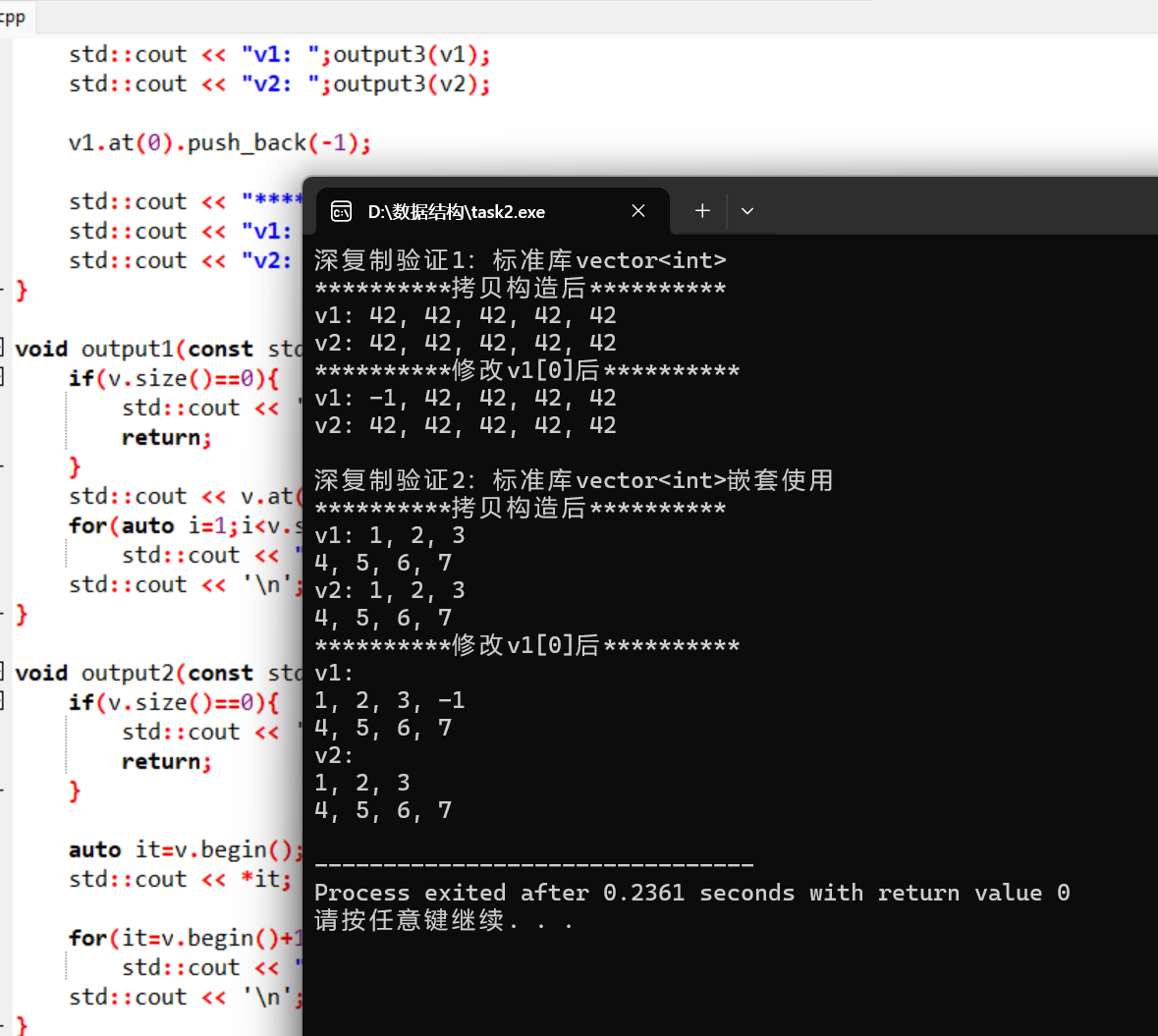
问题1:
std::vector<int> v1(5,42);完成默认构造;const std::vector<int> v2(v1);完成拷贝构造。
v1包含5个值为42的数据项,v2包含5个值为42的数据项。
问题2:
v1.size()=2;v2.size()=2;v1[0].size()=3.
问题3:
能。
区别:v1.at(0)会进行边界检查,v1[0]不进行边界检查。
问题4:
(1)能。v1.at(0)返回第一个内层vector的引用,r是该vector的引用;r.rise()-1是新增元素1的下标,r.at(r.size()-1)可访问到1
(2)优势:避免拷贝,节省内存。
限制:不能通过r修改vector的内容。
问题5:
(1)深复制。
(2)当v是vector<int>时,v.at(0)返回int&;当v是const vector<int>时,v.at(0)返回const int&。at()必须提供const重载版本。
vectorInt.hpp
#pragma once #include<iostream> class vectorInt{ public: vectorInt(); vectorInt(int n_); vectorInt(int n_,int value); vectorInt(const vectorInt &vi); ~vectorInt(); int size() const; int& at(int index); const int& at(int index) const; vectorInt& assign(const vectorInt &vi); int* begin(); int* end(); const int* begin() const; const int* end() const; private: int n; int *ptr; }; vectorInt::vectorInt():n{0},ptr{nullptr}{ } vectorInt::vectorInt(int n_):n{n_},ptr{new int[n_]}{ } vectorInt::vectorInt(int n_,int value):n{n_},ptr{new int[n_]}{ for(auto i=0;i<n;++i) ptr[i]=value; } vectorInt::vectorInt(const vectorInt &vi):n{vi.n},ptr{new int[n]}{ for(auto i=0;i<n;i++) ptr[i]=vi.ptr[i]; } vectorInt::~vectorInt(){ delete [] ptr; } int vectorInt::size() const{ return n; } const int& vectorInt::at(int index) const{ if(index<0||index>=n){ std::cerr << "IndexError:index out of range\n"; std::exit(1); } return ptr[index]; } int& vectorInt::at(int index){ if(index<0||index>=n){ std::cerr << "IndexError:index out of range\n"; std::exit(1); } return ptr[index]; } vectorInt& vectorInt::assign(const vectorInt &vi){ if(this==&vi) return *this; int *ptr_tmp; ptr_tmp=new int[vi.n]; for(int i=0;i<vi.n;++i) ptr_tmp[i]=vi.ptr[i]; delete[] ptr; n=vi.n; ptr=ptr_tmp; return *this; } int* vectorInt::begin(){ return ptr; } int* vectorInt::end(){ return ptr+n; } const int* vectorInt::begin() const{ return ptr; } const int* vectorInt::end() const{ return ptr+n; }
task3.cpp
#include "vectorInt.hpp" #include <iostream> void test1(); void test2(); void output1(const vectorInt &vi); void output2(const vectorInt &vi); int main(){ std::cout << "测试1: \n"; test1(); std::cout << "\n测试2:\n"; test2(); } void test1(){ int n; std::cout << "Enter n: "; std::cin >> n; vectorInt x1(n); for(auto i=0;i<n;++i) x1.at(i)=(i+1)*10; std::cout << "x1: ";output1(x1); vectorInt x2(n,42); vectorInt x3(x2); x2.at(0)=-1; std::cout << "x2: ";output1(x2); std::cout << "x3: ";output1(x3); } void test2(){ const vectorInt x(5,42); vectorInt y; y.assign(x); std::cout << "x: ";output2(x); std::cout << "y: ";output2(y); } void output1(const vectorInt &vi){ if(vi.size()==0){ std::cout << '\n'; return; } std::cout << vi.at(0); for(auto i=1;i<vi.size();++i) std::cout << ", " << vi.at(i); std::cout << '\n'; } void output2(const vectorInt &vi){ if(vi.size()==0){ std::cout << '\n'; return; } auto it=vi.begin(); std::cout << *it; for(it=vi.begin()+1;it!=vi.end();++it) std::cout << ", " << *it; std::cout << '\n'; }
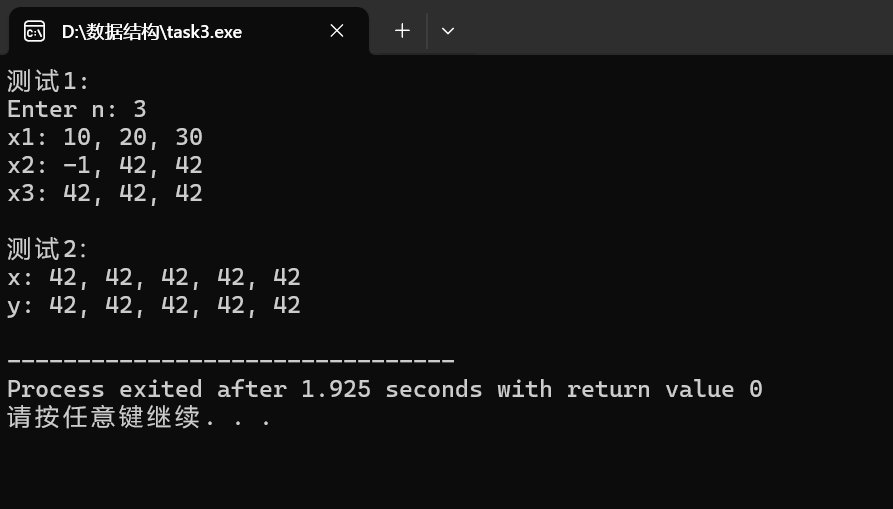
问题1:自赋值崩溃,后续vi.ptr[i]访问的是已释放的内存,导致内存非法访问。
new int[n]内存分配失败,对象处于空悬指针状态,后续操作会导致未定义行为。
问题2:
1.将this的指针类型从vectorInt*转化为const vectorInt*。
转换前vectorInt*;转换后const vectorInt*;
目的:使前者可以调用const类型限制的函数。
2.作用:移除const限定符,将const int&转化为int&转换前const int&转换后int&目的:使非const版本at能返回可修改的引用。问题3:(1)v1.begin()调用非const版本,v2.begin()调用const版本,前者适用于非const版本用于需要修改容器元素的场景,后者适用于只读操作。问题4:可以。
std::fill_n(ptr, n, value);功能是从ptr指向的数组开始,连续填充n个元素,每个元素的值为value.
std::copy_n(vi.ptr, vi.n, ptr);功能是从vi.ptr指向的数组开始,复制vi.n个元素到ptr指向的目标数组.
实验任务4
matrix.hpp
#pragma once #include <iostream> #include <algorithm> #include <cstdlib> // 类Matrix声明 class Matrix { public: Matrix(int rows_, int cols_, double value = 0); // 构造rows_*cols_矩阵对象, 初值value Matrix(int rows_, double value = 0); // 构造rows_*rows_方阵对象, 初值value Matrix(const Matrix &x); // 深复制 ~Matrix(); void set(const double *pvalue, int size); // 按行复制pvalue指向的数据,要求size=rows*cols,否则报错退出 void clear(); // 矩阵对象数据项置0 const double& at(int i, int j) const; // 返回矩阵对象索引(i,j)对应的数据项const引用(越界则报错后退出) double& at(int i, int j); // 返回矩阵对象索引(i,j)对应的数据项引用(越界则报错后退出) int rows() const; // 返回矩阵对象行数 int cols() const; // 返回矩阵对象列数 void print() const; // 按行打印数据 private: int n_rows; // 矩阵对象内元素行数 int n_cols; // 矩阵对象内元素列数 double *ptr; // 数据区 };
matrix.cpp
#include "matrix.hpp" #include <iostream> #include <cstdlib> Matrix::Matrix(int rows_, int cols_, double value) { if (rows_ <= 0 || cols_ <= 0) { std::cerr << "invalid size\n"; std::exit(1); } n_rows = rows_; n_cols = cols_; int total = n_rows * n_cols; ptr = new double[total]; // 初始化 for (int k = 0; k < total; ++k) { ptr[k] = value; } } Matrix::Matrix(int rows_, double value) { if (rows_ <= 0) { std::cerr << "invalid size\n"; std::exit(1); } n_rows = rows_; n_cols = rows_; int total = n_rows * n_cols; ptr = new double[total]; for (int k = 0; k < total; ++k) { ptr[k] = value; } } Matrix::Matrix(const Matrix &x) { n_rows = x.n_rows; n_cols = x.n_cols; int total = n_rows * n_cols; ptr = new double[total]; for (int i = 0; i < total; ++i) { ptr[i] = x.ptr[i]; } } Matrix::~Matrix() { delete [] ptr; } void Matrix::set(const double *pvalue, int size) { int expected = n_rows * n_cols; if (size != expected) { std::cerr << "size not match\n"; std::exit(1); } for (int i = 0; i < expected; ++i) { ptr[i] = pvalue[i]; } } void Matrix::clear() { int total = n_rows * n_cols; for (int i = 0; i < total; ++i) { ptr[i] = 0.0; } } double& Matrix::at(int i, int j) { if (i < 0 || i >= n_rows || j < 0 || j >= n_cols) { std::cerr << "index error\n"; std::exit(1); } return ptr[i * n_cols + j]; } const double& Matrix::at(int i, int j) const { if (i < 0 || i >= n_rows || j < 0 || j >= n_cols) { std::cerr << "index error\n"; std::exit(1); } return ptr[i * n_cols + j]; } int Matrix::rows() const { return n_rows; } int Matrix::cols() const { return n_cols; } void Matrix::print() const { for (int r = 0; r < n_rows; ++r) { for (int c = 0; c < n_cols; ++c) { std::cout << ptr[r * n_cols + c]; if (c != n_cols - 1) std::cout << " "; } std::cout << "\n"; } }
task4.cpp
#include <iostream> #include <cstdlib> #include "matrix.hpp" void test1(); void test2(); void output(const Matrix &m, int row_index); int main() { std::cout << "测试1: \n"; test1(); std::cout << "\n测试2: \n"; test2(); } void test1() { double x[1000] = {1, 2, 3, 4, 5, 6, 7, 8, 9, 10}; int n, m; std::cout << "Enter n and m: "; std::cin >> n >> m; Matrix m1(n, m); // 创建矩阵对象m1, 大小n×m m1.set(x, n*m); // 用一维数组x的值按行为矩阵m1赋值 Matrix m2(m, n); // 创建矩阵对象m2, 大小m×n m2.set(x, m*n); // 用一维数组x的值按行为矩阵m1赋值 Matrix m3(n); // 创建一个n×n方阵对象 m3.set(x, n*n); // 用一维数组x的值按行为矩阵m3赋值 std::cout << "矩阵对象m1: \n"; m1.print(); std::cout << "矩阵对象m2: \n"; m2.print(); std::cout << "矩阵对象m3: \n"; m3.print(); } void test2() { Matrix m1(2, 3, -1); const Matrix m2(m1); std::cout << "矩阵对象m1: \n"; m1.print(); std::cout << "矩阵对象m2: \n"; m2.print(); m1.clear(); m1.at(0, 0) = 1; std::cout << "m1更新后: \n"; std::cout << "矩阵对象m1第0行 "; output(m1, 0); std::cout << "矩阵对象m2第0行: "; output(m2, 0); } // 输出矩阵对象row_index行所有元素 void output(const Matrix &m, int row_index) { if(row_index < 0 || row_index >= m.rows()) { std::cerr << "IndexError: row index out of range\n"; exit(1); } std::cout << m.at(row_index, 0); for(int j = 1; j < m.cols(); ++j) std::cout << ", " << m.at(row_index, j); std::cout << '\n'; }
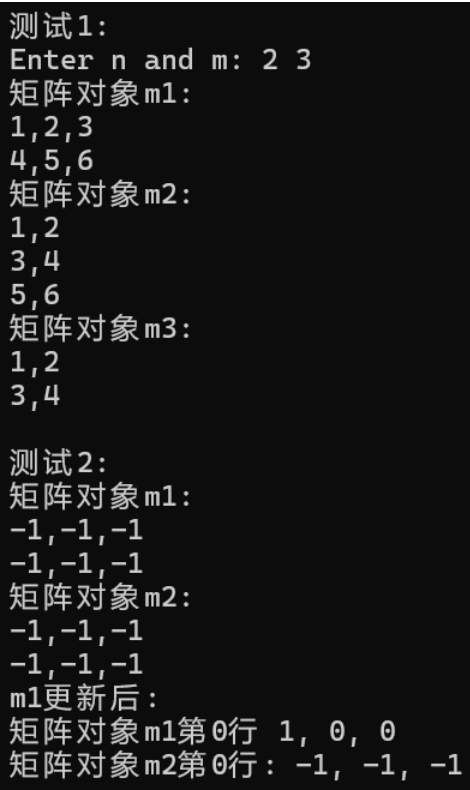
实验任务5
contact.hpp
#pragma once #include <iostream> #include <string> // 联系人类 class Contact { public: Contact(const std::string &name_, const std::string &phone_); const std::string &get_name() const; const std::string &get_phone() const; void display() const; private: std::string name; // 必填项 std::string phone; // 必填项 }; Contact::Contact(const std::string &name_, const std::string &phone_):name{name_}, phone{phone_} { } const std::string& Contact::get_name() const { return name; } const std::string& Contact::get_phone() const { return phone; } void Contact::display() const { std::cout << name << ", " << phone; }
contactBook.hpp
# pragma once #include <iostream> #include <string> #include <vector> #include <algorithm> #include "contact.hpp" class ContactBook { public: void add(const std::string &name, const std::string &phone); void remove(const std::string &name); void find(const std::string &name) const; void display() const; size_t size() const; private: int index(const std::string &name) const; void sort(); private: std::vector<Contact> contacts; }; void ContactBook::add(const std::string &name, const std::string &phone) { if(index(name) == -1) { contacts.push_back(Contact(name, phone)); std::cout << name << " add successfully.\n"; sort(); return; } std::cout << name << " already exists. fail to add!\n"; } void ContactBook::remove(const std::string &name) { int i = index(name); if(i == -1) { std::cout << name << " not found, fail to remove!\n"; return; } contacts.erase(contacts.begin()+i); std::cout << name << " remove successfully.\n"; } void ContactBook::find(const std::string &name) const { int i = index(name); if(i == -1) { std::cout << name << " not found!\n"; return; } contacts[i].display(); std::cout << '\n'; } void ContactBook::display() const { for(auto &c: contacts) { c.display(); std::cout << '\n'; } } size_t ContactBook::size() const { return contacts.size(); } int ContactBook::index(const std::string &name) const { for (size_t i = 0; i < contacts.size(); ++i) { if (contacts[i].get_name() == name) { return static_cast<int>(i); } } return -1; } void ContactBook::sort() { std::sort(contacts.begin(), contacts.end(), [](const Contact &a, const Contact &b) { return a.get_name() < b.get_name(); }); }
task5.cpp
#include "contactBook.hpp" void test() { ContactBook contactbook; std::cout << "1. add contacts\n"; contactbook.add("Bob", "18199357253"); contactbook.add("Alice", "17300886371"); contactbook.add("Linda", "18184538072"); contactbook.add("Alice", "17300886371"); std::cout << "\n2. display contacts\n"; std::cout << "There are " << contactbook.size() << " contacts.\n"; contactbook.display(); std::cout << "\n3. find contacts\n"; contactbook.find("Bob"); contactbook.find("David"); std::cout << "\n4. remove contact\n"; contactbook.remove("Bob"); contactbook.remove("David"); } int main() { test(); }
运行结果
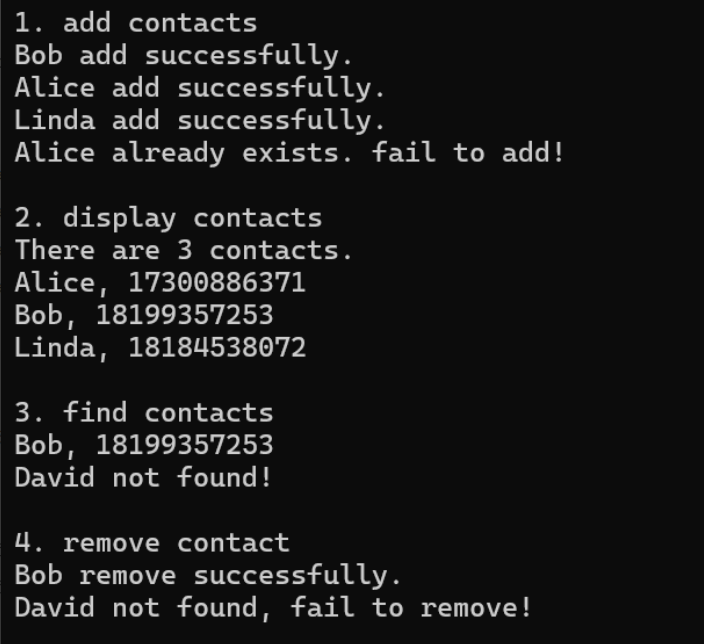




 浙公网安备 33010602011771号
浙公网安备 33010602011771号